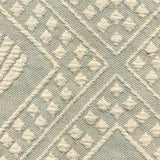Textile Terms Explained: Matelassé
Matelassé is a French weaving technique characterized by a “puffed” pattern. This style of weaving was originally created to imitate that were famous in the South of France.

The matelassé weaving technique has also been used to imitate an Italian style of quilting called “trapunto.” This style of quilting emerged in 14th century Sicily and quickly spread to other parts of Europe including France. This may have been the initial spark that lead to the invention of the matelassé style of weaving. One of our most famous matelassé bedspreads is inspired by “trapunto”, the Abigail Adams (see photo at right).
Today, our weavers use jacquard looms (invented in France in the 18th century) to weave matelassé bedspreads. Matelassé patterns can also be created by hand or with a quilting machine.
The two major weaving styles that are utilized in the creation of our bedspreads are the matelassé and terry (also known as “candlewick” or “chenille”). Both require a jacquard loom to create, however, the major differences can be seen in the texture of the fabric and the complexity of the designs. The magnified swatches below show the terry weave on the left and the matelassé weave on the right:


Typically, matelassé bedspreads are much more detailed and delicate in terms of design because of the nature of the matelasse weave being much less restrictive. If you look at a terry bedspread, the restrictive grid required by the weaving style confines the designer to some degree.
Browse examples of matelassé bedspreads
